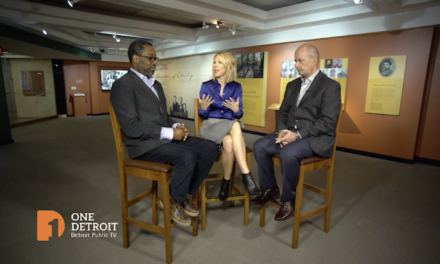How has the shift to remote and hybrid work impacted downtown Detroit’s vibrancy? Has the pandemic upended the notion that downtowns thrive on in-office workspaces and large company headquarters?
When workers were able to return to the workforce, Detroit saw less than 16% of its workforce return to offices downtown, Downtown Detroit Partnership CEO Eric Larson said. Starting off in 2023, Detroit’s downtown workforce now sits at about 30%-40%. Larson predicts the city’s workforce population might hit its ceiling at about 70% as the city’s workforce continues to return closer to pre-pandemic levels.
As Detroit continues its return to work efforts, and employers realize what their post-pandemic strategy may be, One Detroit contributor Nolan Finley, of the Detroit News, sits down with Eric Larson at the 2023 Detroit Policy Conference to have a conversation about the ongoing shift in the way we work and how that’s impacting downtown Detroit’s vibrancy.
They talk about what may happen to several now- or soon-to-be-vacant office buildings downtown as companies downtown their physical workspaces, and the opportunities that Detroit is realizing through additional investments in hotel and visitor accommodations. Plus, they discuss the challenges businesses have faced throughout the pandemic, including a lack of foot traffic that extends into the present day and the inability to find workers.
“We need more residential to attract— the millennial-aged resident has more than doubled downtown in the last decade,” Larson said about the number of young professionals wanting to live in downtown Detroit versus the number of residences available to them.
In his 30 years of real estate experience, Larson has developed, financed, owned, and managed over $3 billion in Detroit real estate, including the Renaissance Center, Little Caesar’s Arena, and The A. Alfred Taubman Center for Design Education.
Full Transcript:
Nolan Finley, The Detroit News: Well, we’re joined now by Eric Larson, CEO of the Downtown Detroit Partnership. Eric, thanks for joining us.
Eric Larson, Chief Executive Officer, Downtown Detroit Partnership: I would not want to be anywhere else, Nolan. Thank you.
Nolan Finley: So, Erik. You’ve watched downtown for a long time. You were part of its comeback for many years. Going into the pandemic, the prevailing notion was, if you wanted to attract young creative workers, you had to have an office downtown.
We saw all sorts of companies opening offices downtown to attract talent. That sort of upended by the pandemic. Now, if we want to attract those same workers. The key is flexibility. They want to be able to work from where they want to work when they want to work. How is that impacting the downtown workforce?
Eric Larson: Yeah, Nolan, that’s a great point. And thank you for covering, not only this conference but also this conversation. Because for the Downtown Detroit Partnership, we’ve been at this for a long time. And we went from some incredible momentum pre-pandemic to some real low points. I mean, we had less than 16% of the work population… For a while, we had none of the work population. But when people were able to return, we had less than 16% of the work population coming back into the office.
We’re now, on a good day, so Tuesday, Wednesday, Thursday, we’re at about 45% to 60% of what used to be the high watermark. The high watermark was 80,000 people in the core of the downtown on a daily basis, five days a week. So we’re probably at about, on average, 25,000 if you spread that throughout the week. So we’re at somewhere around 30% to 40% of what we were at.
We were talking about this before. My guess is we’ll probably even out someplace around 70% of that work population coming back. There’s a portion of the work population that has to be in the office. They just can’t do their job without being physical. But there’s a big portion that’s going to want that flexibility. And employers are trying to figure out how to provide that flexibility.
Nolan Finley: Are you seeing most employers going to a hybrid model? Some days at home and some days in the office. What’s sort of the optimum that you’re seeing? What are they settling on?
Eric Larson: Absolutely. I haven’t seen an employer yet that has mandated five days a week. Everybody is saying… Typically, it’s two days a week. There are often splitting their work population. Partly, that help relieve the pressure in the office, but also to try and spread the benefit of having people in downtown between two days. So some of them will be Tuesday, Thursday, some of them will be sort of Wednesday, Fridays. But for the most part, it’s concentrated in the center of that work week. And I think that what we’ll see, Nolan, is we’ll see most companies continue that flexibility.
We went from during the pandemic, and you reported a little bit about this, employers really had no leverage. There was no political, much less, sort of appropriate way to force people back in. As we get further away from the pandemic, as people get more comfortable with their health and everything else, we’ll see people get back to some level of normalcy, but it will never be the same.
Nolan Finley: Let’s talk about the impact on the real estate market. We built a lot of office space prior to the pandemic in anticipation of an ever-growing downtown workforce. What’s happening to that space now? Are businesses looking for smaller footprints?
Eric Larson: Well, like anything in any situation, in any part of our economy, there’s a flight to quality. So the office is no different. So when there is a downturn, whether it’s a downturn caused by a pandemic or a downturn because of the economy, typically tenants will move from B and C-class properties to A-class properties. So you’ll see some movement.
You just saw the announcement from the Detroit Regional Chamber. They’re moving from 1001 over to One Kennedy Square, not because necessarily it’s an A or B or a C, but because they are downsizing. And so you’ll see that. Deloitte moved out of the Renaissance Center into WeWork space that was not being utilized the way WeWork expected it to be utilized.
And they’ve made that a global platform solution around the country. So I think we’ll see offices scale back, but we won’t see the immediate effect of that because leases have terms. That will take place over the next 3 to 5 years. We’ll start to feel the effects of people being able to downsize and reconfigure their space. And then we’ll also work on things like this federal legislation that we’ve got going through with Debbie Stabenow that’s sponsored to take office buildings that are 25 years or older and provide some obsolete tax credits to help them get repurposed as residential or incubator spaces, or educational, but some other use.
Nolan Finley: So when you look at this excess office space we’re going to have, what do you see it becoming? Commercial space? Housing?
Eric Larson: Most of it— And we’ve seen this because we had a lot of old space that, that’s where the tax credits were, that already has been converted into residential. A lot of it will be residential. The residential demand, Nolan, outstrips our supply by a lot. I mean, we are virtually 100% leased in the downtown. Our population over the last decade in the downtown has grown by 40%. We need more residential to attract. The millennial-aged resident in downtown has more than doubled in the last decade.
Nolan Finley: They still find downtown an attractive place to live, even if they might not be going into an office.
Eric Larson: Yeah, absolutely. They love the restaurants. They love the outdoor lifestyle that’s provided by the Detroit riverfront and the amazing work that they’ve done, our seven parks, all of that is stuff that attracts people that want to live. Now, there’s a point at which those grow up, they get married, they have kids, and then we got to solve the other issues. But there is a huge demand for residential. Now, when I say huge, we’re delivering a thousand units, roughly a year. That’s a reasonable amount of units but we’re not going to saturate our demand any time soon at that pace.
Nolan Finley: What’s happened to the restaurants and businesses that depend on a vigorous downtown workforce?
Eric Larson: They were decimated. I mean, again, you’ve reported a little bit. We’ve talked about it. Small businesses in general, not just restaurants and bars, but small businesses in general. And I don’t think we truly know and I’m not sure that we’ll ever really know the real number of those businesses that have now failed because of the lack of business.
But a number of businesses closed. Some of those closed and then have reopened. But a lot of the restaurants are having a hard time getting their workforce back, no different than the hotels and the hospitality industry. And so while they’re back to pre-pandemic levels of revenue, they aren’t necessarily back to the same level of occupancy. Again, the flight to quality happened. So the really good restaurants are fully booked. It’s hard to get a restaurant reservation but there are a lot of them that are still struggling.
Nolan Finley: And I’ve noticed I mean you look out the window onto the street. Where before the pandemic, we’re starting to see crowds up and down the street, like a big city. Now, a lot of days, it feels like 1999 when you can walk from one end of Lafayette or Fort Street and hardly pass anybody else.
Eric Larson: I feel the same thing. I’m actually one of those that’s in the office every day of the week and so I feel it on the good days and on those days that it’s a bit more quiet.
Nolan Finley: It’s hard to find a place to eat lunch.
Eric Larson: It is. A lot of the restaurants have, again, partly because of the labor situation and partly because of the demand, have closed for lunch. But I think, Nolan, that’s where the opportunity lies, not to suggest that it isn’t a problem, but that is really where some of the opportunity lies. As we create a more 24/7 economy, as we increase our residential population, as we continue to work on some of these educational higher ed solutions through these centers of innovation, whether it’s the Michigan Central or The Center for Innovation with the University of Michigan. Those are things that are going to really be, I think, drivers for additional population in the downtown and our visitors.
The amount of interest by these large events. We’ve got the draft in 2024, we’ve got the final four in 2027, we’ve got the Grand Prix returning to the streets this year. All of those are generating a lot more activity and traffic now. They need to be throughout the year. They can’t be episodic. But that in itself… We have 37 million visitors a year in downtown.
Nolan Finley: And we just ran a piece in the Detroit News about the growth in the hotel market here. A lot of small to midsize hotels are popping up everywhere around town. In Cork Town where your businesses are located. Is Detroit still considered a hot spot for conventions or other gatherings of that sort?
Eric Larson: Yeah, you and I have been around long enough to remember when we had five citywides, five conventions where they would take all the hotels. That has now totally changed. The level of interest is there. But the interesting thing is, we saw it in some of the recent publications listing Detroit as one of the top 100 places or top ten places to visit. People want to come, they want to see the architecture, they want to check out the food scene because it’s a really unique food scene, and it’s very walkable and inviting.
And so, yeah, we have over 700 new hotel rooms that are being delivered this year. We have a bunch of hotels that have been announced. We have the new funding from the state that’s going to help with the convention hotels. So that’ll support larger blocks of rooms, which is necessary for the big events and big conventions. So yeah, I feel really bullish about that.
Nolan Finley: Well, Eric, thanks a lot. We appreciate you joining us on “One Detroit” and thanks for what you do for the city.
Eric Larson: Well, I appreciate you. And thank you, my friend. It’s always good to be with you. Thank you.
Stay Connected:
Subscribe to One Detroit’s YouTube Channel & Don’t miss One Detroit Mondays and Thursdays at 7:30 p.m. on Detroit Public TV, WTVS-Channel 56.
Catch the daily conversations on our website, Facebook, Twitter @DPTVOneDetroit, and Instagram @One.Detroit
View Past Episodes >
Watch One Detroit every Monday and Thursday at 7:30 p.m. ET on Detroit Public TV on Detroit Public TV, WTVS-Channel 56.




